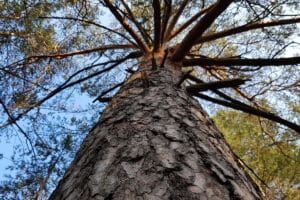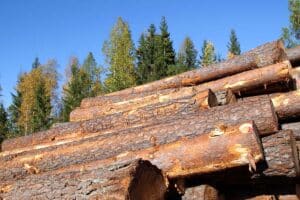Calculating a mathematical average represents one approach for assessing data, or for establishing baselines or trends in the marketplace. However, averages come in different forms. When conducting forest industry research and timber market analysis at Forisk, we often use rolling and weighted averages to better leverage underlying data. These approaches also inform our thinking on how to set prices for timber forecasts and forest finance decisions.
Rolling Averages
A rolling, or “moving,” average provides a way to measure trends over time. This can be useful when tracking markets and businesses from monthly or quarterly data, such as housing starts and the prices of forest products. For example, the COVID-19 pandemic initiated two years of extreme volatility with softwood lumber prices. When evaluating margins and the ability-to-pay for wood, we want to avoid over-exposure to outliers, as when lumber exceeded $1,500 per MBF in mid-2021. A rolling average cuts a path through the cycle to “smooth out” reported prices while still including recent data. Then, we might apply the last three, six or twelve-month average lumber price, in the $400 to $500 range, to fairly assess the potential profitability of a business or sector.
For timber price forecasts, where quarterly data can move significantly with major weather events or mill-specific disruptions, a four-quarter or multi-year rolling average offers a firmer starting assumption for projecting future conditions and testing scenarios. While our baseline may lag, relying on an extreme quarterly data point makes it harder to forecast because the projections will bounce more based on short-term factors than from long-term fundamentals and physical facts. A rolling average can provide a better sense of the underlying health of the market as it moves for projecting forward.
Weighted Averages
A weighted average accounts for the relative importance of certain aspects of the data. This differs from a simple average, which treats all observations in a data set equally. For example, in 2022 in the U.S. South, the four-quarter rolling average price of pine sawtimber was $27.79 per ton according to TimberMart-South (TMS). This is a simple average of 11 state-level prices from TMS, from Texas to Virginia to Florida. However, when we weight those prices by Forisk’s assessment of wood demand and capacity by mill and state, we get $28.59 per ton, about 3% higher.
The difference reminds us how higher volume states with more sawmills and higher production levels tend to report higher prices and vice versa. Georgia, with a 2022 state-level average price of $33.43 per ton, consumed around 13 million tons of pine sawtimber in 2022, while Virginia, which used around 3 million tons over the same period, reported a per ton sawtimber price of $21.17.
We take this a step further in the Forisk Research Quarterly when forecasting regional sawtimber prices by combining approaches to calculate a rolling weighted average of state-level forecasts. This more accurately captures the value of wood delivered regionally and better supports client timberland investment decisions.
While timberland assets are, on average, valued based on their ability to generate income from reported prices, “on average” is not “always.” Rigorous analysis of a situation benefits from the proper, context-appropriate application of available tools and methods to set baselines for forecasts and investment analysis.
This content may not be used or reproduced in any manner whatsoever, in part or in whole, without written permission of LANDTHINK. Use of this content without permission is a violation of federal copyright law. The articles, posts, comments, opinions and information provided by LANDTHINK are for informational and research purposes only and DOES NOT substitute or coincide with the advice of an attorney, accountant, real estate broker or any other licensed real estate professional. LANDTHINK strongly advises visitors and readers to seek their own professional guidance and advice related to buying, investing in or selling real estate.










Add Comment